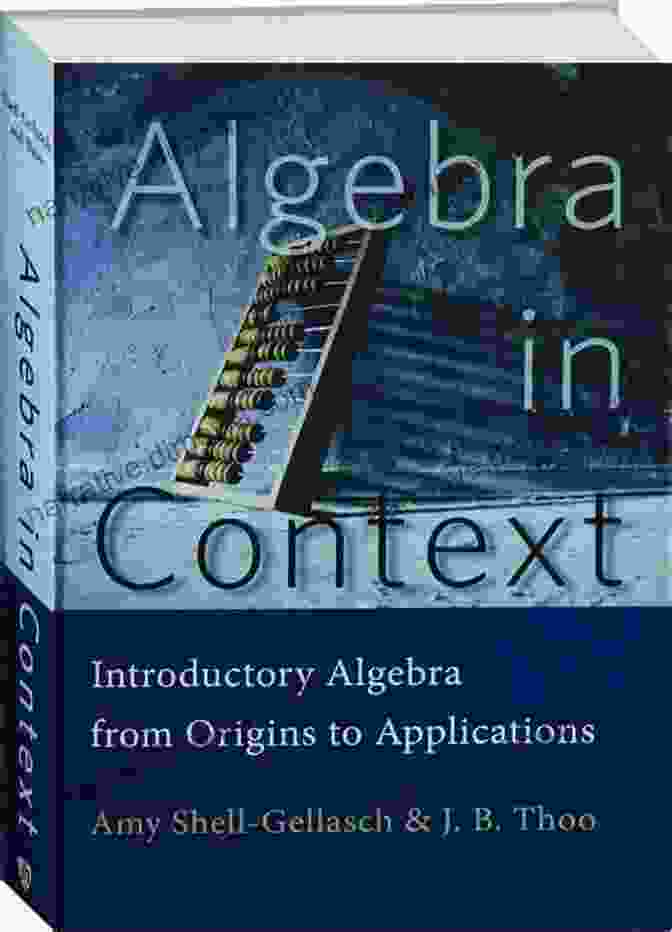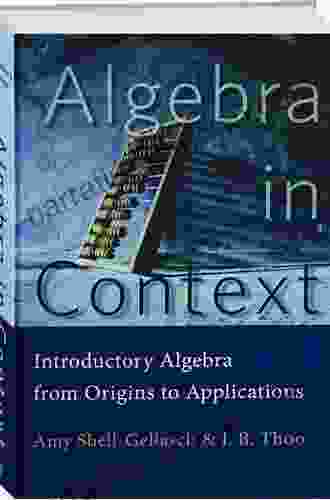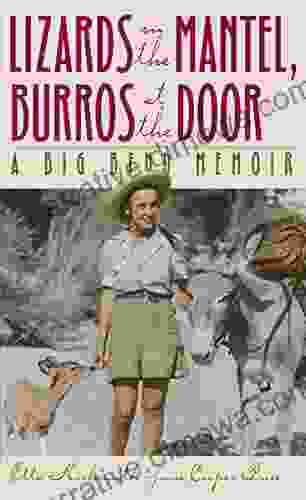Journey Through the Origins and Applications of Algebra: An Immersive Guide to Introductory Algebra

Unveiling the Rich History and Practical Impact of Algebra

Algebra, a cornerstone of mathematics, has a captivating history and an extensive range of applications. From its humble beginnings in ancient Mesopotamia to its modern-day uses in diverse fields, algebra has played a pivotal role in shaping our understanding of the world. In the book "Introductory Algebra From Origins To Applications," Dr. Arnold Adelberg provides a comprehensive exploration of algebra, tracing its evolution from ancient times to its contemporary significance.
5 out of 5
| Language | : | English |
| File size | : | 36064 KB |
| Text-to-Speech | : | Enabled |
| Screen Reader | : | Supported |
| Enhanced typesetting | : | Enabled |
| Print length | : | 553 pages |
1. The Dawn of Algebra in Ancient Civilizations
The roots of algebra can be traced back to the ancient civilizations of Mesopotamia and Egypt. Around 1800 BC, the Babylonians developed a system of notation that could represent mathematical operations such as addition, subtraction, multiplication, and division. These notational innovations laid the foundation for the development of algebraic equations and the solving of mathematical problems.
In Egypt, the ancient Egyptians used a different system of notation but also engaged in algebraic thinking. The Rhind Mathematical Papyrus, dating back to around 1650 BC, contains evidence of the Egyptians' ability to solve linear equations and calculate volumes of geometric shapes.
2. The Greek Geometric Tradition
In the 6th century BC, the Greek philosopher and mathematician Pythagoras founded the Pythagorean school in Croton, Italy. The Pythagoreans developed a system of geometric proofs and were known for their study of number theory. Their work laid the groundwork for the development of algebraic concepts such as the Pythagorean Theorem and the concept of incommensurable numbers.
Another important figure in the Greek geometric tradition was Euclid, who wrote the influential treatise "The Elements" in the 3rd century BC. In this work, Euclid presented a systematic approach to geometry, including the famous axiomatic method. "The Elements" became a standard textbook for centuries and had a significant impact on the development of algebra and other branches of mathematics.
3. The Rise of Symbolic Algebra in the Middle Ages
During the Middle Ages, mathematicians began to develop symbolic notation for algebraic operations. In the 9th century AD, the Persian mathematician Al-Khwarizmi wrote his treatise on algebra, which introduced the concept of the unknown as a symbol. This innovation allowed for the development of more general and abstract algebraic equations.
In the 12th century, the Indian mathematician Bhaskara II developed further algebraic techniques, including the method of completing the square for solving quadratic equations. His work had a significant impact on the development of algebra in India and beyond.
4. The Golden Age of Algebra in the Renaissance
The Renaissance period witnessed a renewed interest in mathematics and the study of algebra. European mathematicians such as Girolamo Cardano and François Viète made significant contributions to the field. Cardano developed methods for solving cubic and quartic equations, while Viète introduced the use of variables to represent unknown quantities.
The work of these mathematicians laid the foundation for the development of modern algebra. In the 17th century, René Descartes invented analytic geometry, which combined algebra and geometry to create a powerful new tool for solving geometric problems.
5. The Development of Abstract Algebra in the 19th Century
In the 19th century, mathematicians began to develop more abstract approaches to algebra. The Irish mathematician William Rowan Hamilton developed quaternions, a system of four-dimensional numbers, while the Norwegian mathematician Niels Henrik Abel laid the foundation for Galois theory, which deals with the solvability of polynomial equations.
These advances led to the development of abstract algebra, which studies algebraic structures such as groups, rings, and fields. Abstract algebra has found applications in diverse areas such as coding theory, cryptography, and quantum mechanics.
6. Modern Applications of Algebra
Algebra has a wide range of applications in modern-day society. It is used in fields such as:
- Computer science: Algebra is used in areas such as coding theory, cryptography, and data analysis.
- Physics: Algebra is used in areas such as quantum mechanics, particle physics, and cosmology.
- Economics: Algebra is used in areas such as game theory, mathematical finance, and econometrics.
- Biology: Algebra is used in areas such as population genetics, bioinformatics, and systems biology.
"Introductory Algebra From Origins To Applications" by Dr. Arnold Adelberg provides a comprehensive overview of algebra, tracing its historical development and exploring its modern applications. This book is an invaluable resource for students, teachers, and anyone interested in gaining a deeper understanding of one of the most important and influential branches of mathematics.
5 out of 5
| Language | : | English |
| File size | : | 36064 KB |
| Text-to-Speech | : | Enabled |
| Screen Reader | : | Supported |
| Enhanced typesetting | : | Enabled |
| Print length | : | 553 pages |
Do you want to contribute by writing guest posts on this blog?
Please contact us and send us a resume of previous articles that you have written.
 Book
Book Novel
Novel Page
Page Chapter
Chapter Text
Text Story
Story Genre
Genre Reader
Reader Library
Library Paperback
Paperback E-book
E-book Magazine
Magazine Newspaper
Newspaper Paragraph
Paragraph Sentence
Sentence Bookmark
Bookmark Shelf
Shelf Glossary
Glossary Bibliography
Bibliography Foreword
Foreword Preface
Preface Synopsis
Synopsis Annotation
Annotation Footnote
Footnote Manuscript
Manuscript Scroll
Scroll Codex
Codex Tome
Tome Bestseller
Bestseller Classics
Classics Library card
Library card Narrative
Narrative Biography
Biography Autobiography
Autobiography Memoir
Memoir Reference
Reference Encyclopedia
Encyclopedia Andy Mangels
Andy Mangels Andrew P Hills
Andrew P Hills Duane Forrester
Duane Forrester Andrea Hackett
Andrea Hackett Andrew Lane
Andrew Lane Angeline Truong
Angeline Truong Hein De Bont
Hein De Bont Janice Johnson
Janice Johnson Amornrat Boonyarit
Amornrat Boonyarit Don Robinson
Don Robinson Andrew Buchanan
Andrew Buchanan Andy Du Port
Andy Du Port Amy Pilkington
Amy Pilkington Ken Hunt
Ken Hunt Universal Politics
Universal Politics Andy Tooley
Andy Tooley Martin Widmark
Martin Widmark Andy Schrock
Andy Schrock Sherri Winston
Sherri Winston Andra Damron
Andra Damron
Light bulbAdvertise smarter! Our strategic ad space ensures maximum exposure. Reserve your spot today!

 Jules VernePriscilla the Great Versus the World: A Riveting Tale of Courage, Resilience,...
Jules VernePriscilla the Great Versus the World: A Riveting Tale of Courage, Resilience,...
 Jackson BlairCopenhagen Through the Lens of Andrey Taranov: A Visual Masterpiece of Beauty...
Jackson BlairCopenhagen Through the Lens of Andrey Taranov: A Visual Masterpiece of Beauty... Mario BenedettiFollow ·19.6k
Mario BenedettiFollow ·19.6k Gary CoxFollow ·6.6k
Gary CoxFollow ·6.6k Dylan HayesFollow ·16.2k
Dylan HayesFollow ·16.2k Arthur MasonFollow ·8.7k
Arthur MasonFollow ·8.7k Shane BlairFollow ·5k
Shane BlairFollow ·5k Edward BellFollow ·12k
Edward BellFollow ·12k Christian BarnesFollow ·2.4k
Christian BarnesFollow ·2.4k Darren NelsonFollow ·9k
Darren NelsonFollow ·9k
 Milton Bell
Milton BellLiterary Cabins: A Glimpse into the Creative Havens of...
Unveiling the secrets of literary creation,...

 Cameron Reed
Cameron ReedEmbark on an Extraordinary Journey with Anh Do's "Extra...
Dive into the Hilarious, Heartfelt, and...

 Herman Mitchell
Herman MitchellSado: Japan's Island in Exile - Explore a Hidden Gem Rich...
Sado Island, a hidden...

 Abe Mitchell
Abe MitchellJeff Madison and the Shimmers of Drakmere: An Enchanting...
In the heart of the...

 Everett Bell
Everett BellRadiation: An Energy Carrier - Unlocking the Secrets of...
In the vast realm of...
5 out of 5
| Language | : | English |
| File size | : | 36064 KB |
| Text-to-Speech | : | Enabled |
| Screen Reader | : | Supported |
| Enhanced typesetting | : | Enabled |
| Print length | : | 553 pages |










